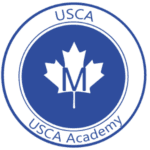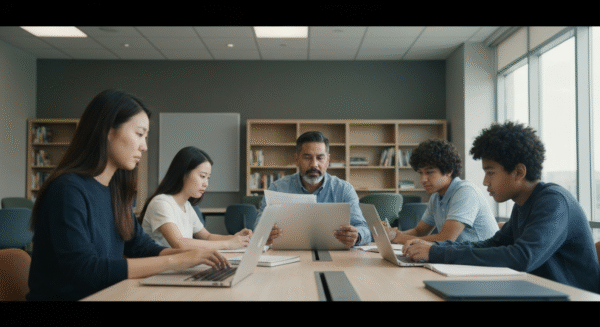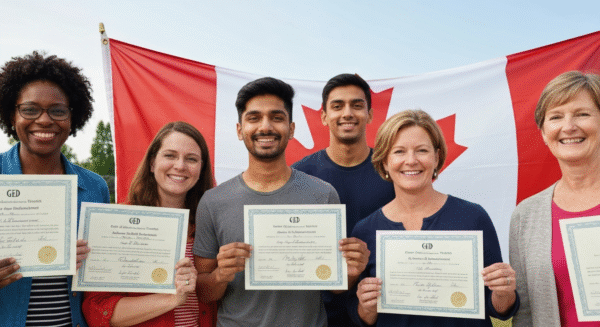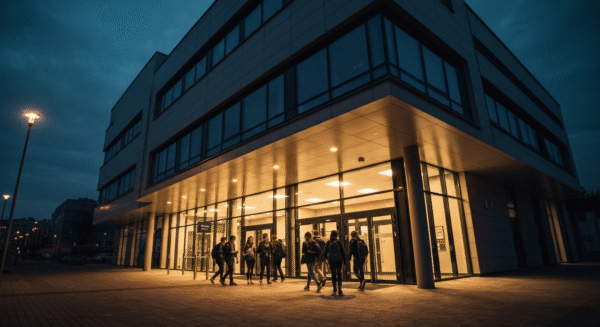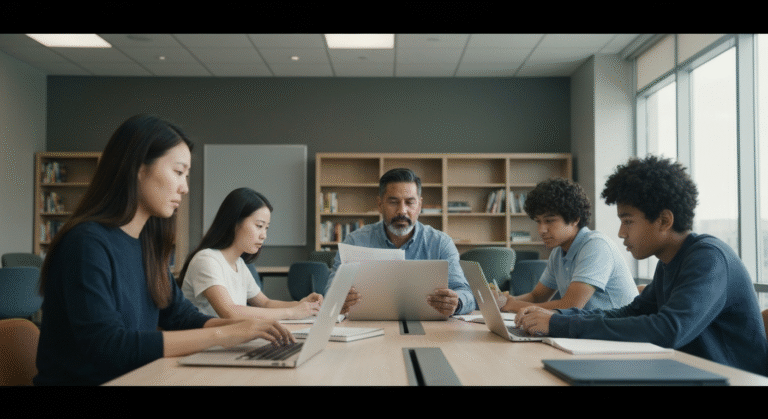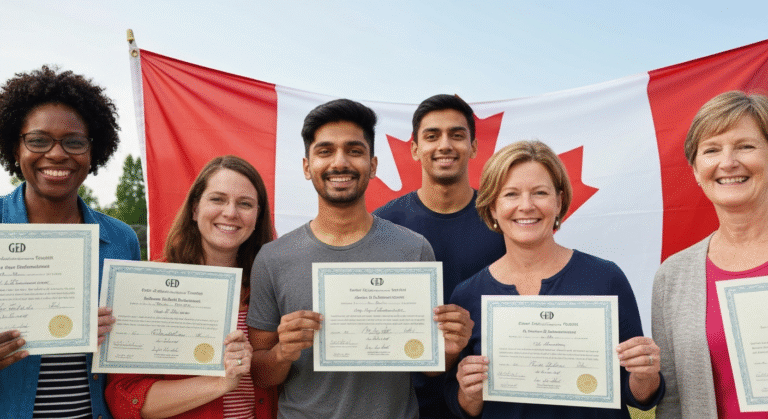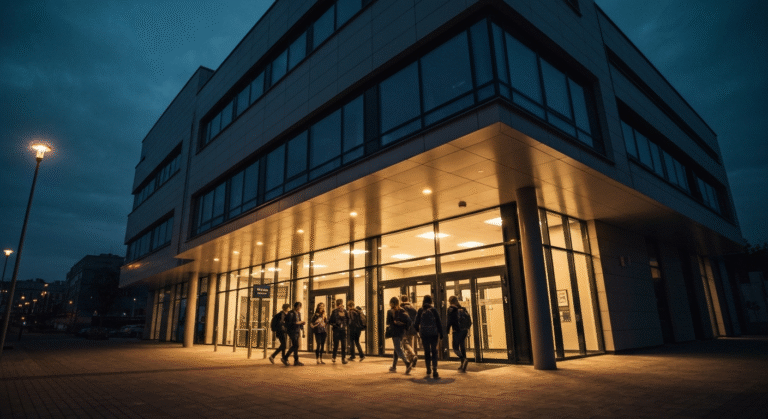Key Highlights of Canadian Department of Education
- The education system in Canada has many parts. Each province and territory has its own school system. They set their own government standards for public education.
- The provincial governments look after the curriculum, teacher certificates, and school boards. The Council of Ministers of Education, which has the Minister of Education, helps all areas in Canada talk together about education policy.
- Canada welcomes international students to its education system. There are special schools called designated learning institutions. There is a clear permit process for those who want to study in Canada.
- The federal government helps with post-secondary programs, Indigenous education, and literacy. It aims to bring quality education with national policies and works with others for better schools.
- Public education in Canada supports bilingual learning, STEM subjects, trades, and looks after special education needs. This helps keep good academic standards in every area.
- Provincial ministries in Ontario, British Columbia, and Quebec show that each place has its own school system. But, they all want to give quality education to their people.
Introduction
The way education works in Canada is strong and has many parts. The country is known for giving high quality education to all its people no matter where they live. Both the federal and provincial governments have roles in this. These two work together. Because of this teamwork, students can learn in many places. There are public and private schools, vocational schools, and universities in Canada.
If you look at what each group does and see how new needs and ideas come in, you understand that Canada is always trying to meet what people want. This is why the education system in Canada keeps changing to give quality education for everyone.
What Is the Canadian Department of Education?
The Canadian Department of Education manages the education system in Canada. This department works with federal, provincial, and territorial governments. That means everyone has a part in making sure the education system works well. It checks what people need in education and wants all students to get the same, quality education.
The department of education makes rules and plans that fit what each part of Canada needs. They also work with the educational communications authority. This helps students do well in school and later in life. The education system in Canada tries to help every student.
Overview of Canada’s Decentralized Education System
One thing that is different about canada’s education system is that it does not have just one group in charge. In canada, the education system is run by provincial governments, for example in manitoba. This means each province can choose what is best for its own people and schools. Because of this, things like how classes are taught, how schools get money, and who runs the schools can be different from one province to another.
Local school boards have more say over what happens in schools. They have to listen to people in their town or city. This helps people feel like they are a part of how the schools work in Canada. Because of this, the education system stays important for all groups in the country. It also helps Canada’s education system stay useful and good for everyone.
Role of Government Bodies at Federal and Provincial Levels
At the federal level, the government of Canada sets the big rules for the education system. These rules help each province decide what to do. The government of Canada also looks after the money that goes to schools and does other programs. Its main goal is to make sure all students in Canada have a good and open education system, so everyone can learn well here.
The provinces and territories in Canada, like Newfoundland, take care of their own schools. They follow the national rules, but they can change things or add more rules that fit them best. The government in each province makes sure to build good school programs. They set goals and make plans so that their schools do well. They try to help all their people and students, even those who need more help. Because of the way the education system works in Canada, it can fit the needs for many kinds of students. In this way, the education system in Canada works for everyone.
Federal Role in Canadian Education
The federal role in the education system in Canada is very important. The government of Canada works hard to give people better access to quality education. It also works to make sure the rights found in the Canadian Charter of Rights and Freedoms are followed.
The government of Canada and the provincial governments work together to support secondary education. They help indigenous students. They also back programs that help improve reading and writing skills.
There are national policies so that all students in Canada can get a good education system, no matter where they live. The government works with other groups to make sure what students learn matches the skills needed for jobs.
This teamwork helps people, schools, and workers all over Canada. It helps everyone get the education and skills they need now and later.
Post-Secondary, Indigenous & Literacy Initiatives
Canada puts a lot of focus on learning for everyone. The education system in Canada has many different Canadian education programs. The country has several kinds of secondary schools and colleges. There are also programs in Canada made to help Indigenous people. Schools have reading and writing classes, too, for people who need more help. The schools and colleges in Canada want all people to get a fair chance. They set up special ways for people who do not get as many chances, so everyone gets the education they need.
The education system in the Northwest Territories includes Indigenous cultural views. At the same time, it works to help more students do well in school. The reading and writing programs are set up to help people who need more help. A lot of these people may not have as much money or may live in some areas. With these changes, Canada lets people get quality education. This helps everyone get ready for the labour market, find good jobs, and improve their lives.
National Policies Supporting Education Across Canada
In Canada, national policies are very important when it comes to the education system. The Council of Ministers of Education Canada takes the lead in this work. They make sure that students in every area of the country get quality education. The federal government also helps with the education system by putting in plans to give support. These plans are made to be fair, and they help all students, including those who have special education needs and come from different backgrounds.
These rules ask the federal government and the provincial governments to support each other. They are about early childhood education, reading, writing skills, and job training. When the federal government and the provincial governments work as one, all students get a chance to learn in good places. This helps them get ready for what will come next in life.
Provincial Responsibilities and Curriculum Standards
The education system in Canada is not the same everywhere. In each province, there is a different way to run schools and set up the curriculum. This helps make sure that academic standards meet what people in that place need. School boards in each area also help lead and watch how the schools work. They can also change things if they need to. This is how the education system in Canada gives good and quality education.
In Alberta, British Columbia, and Prince Edward Island, there are programs for students who need help in special education or want to learn job skills. In Canada, public schools and private schools can teach in ways that are best for their students. This makes Canada a good place for secondary education. The country works to make sure all people can have a good education in high school.
Curriculum Design, Exams & Assessments Across Provinces
In Canada, curriculum design is both independent and joined across the provinces. Each place in the country makes its own learning plan. That way, the plan fits what the local people need. Still, the provinces follow rules from the Council of Ministers of Education. There are checks and tests given every school year, but these are not always the same in every area. The rules can also be different between public and private schools.
This system helps all students keep up good learning in schools. Students get many ways to learn new things, and it starts from kindergarten and keeps going up to secondary education.
Teacher Regulation, School Boards & Local Governance
Regulations for teachers are important for keeping the education system strong in Canada. Each province has school boards that check if teachers have the right qualifications. Teachers also need to do ongoing professional development. This helps them meet the standards set by the education system. Local leaders and people from the community work with the school boards to decide on the rules for public education. This means the schools can meet the unique needs of each area.
So, parents, teachers, and other people all work together to make public education better. Because of the work done by provincial governments and school boards, public education in Canada is good and treats all students fairly. These groups help to keep the education system at a high standard.
Key Programs in Canada’s Education System
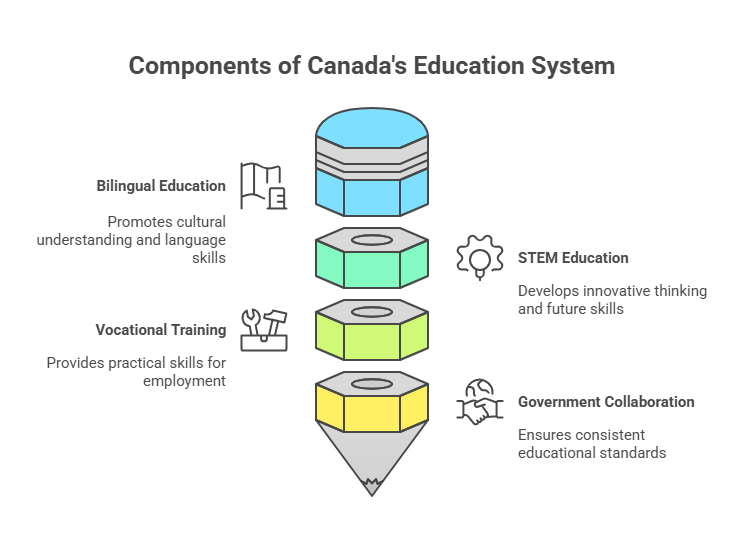
Many programs help make Canada’s education system strong. These programs give students more ways to learn and grow. The education system in Canada gives people a chance to study in both English and French. This is good for Canada, as it brings people from different places together. STEM projects help students think in new ways to find new ideas. These programs help students get ready for work now and later. Canada’s education system works hard to give everyone good chances to learn.
Vocational schools in Canada help students learn by doing and using their hands. You practice real skills that employers want. If you go to one of these schools, you can get a vocational certificate. A certificate from vocational schools in Canada can help you find good jobs.
The education system in Canada is run by both the federal government and provincial governments. They work together to make strong rules for schools. This teamwork makes sure all students get a good education, no matter where they are. Because of this, the education system in Canada helps everyone, in every place.
French-English Bilingual Education, STEM, and Trades
Bilingual education in Canada brings people from different cultures closer together. It helps students get strong in both French and English. This way, everyone can have the same chance to do well. It also makes students more open in how they think. When Canada adds STEM education, it helps people learn skills that will be needed for jobs down the line.
Training in trades lets students practice real skills and gets them ready for jobs a lot of people want. All these things show that Canada cares about giving quality education, and works hard to help many people in the country.
Support for International Students in Canada
Moving to Canada as an international student can feel easier because there are many support systems for you. The main schools, called designated learning institutions, help with steps for your study permit. This is so you can get started in canada’s education system without too much stress. In public schools, students have ways to get help with their schoolwork. These services make it simpler to learn new things about studies and canada’s culture, so students feel good here.
There are people whose job is to help you feel part of your new school and community. This can help you make friends, feel at home, and do well in your studies. Public schools and the full education system in canada try to give quality education to all students, no matter where you come from. The education system in canada wants every student to feel welcome, get the help they need, and do their best.
Designated Learning Institutions & Permit Process
Designated Learning Institutions (DLIs) play a big role in the education system of Canada. They help international students who want quality education. The federal government checks these schools to be sure they meet their rules. This helps all students get support and good education in Canada.
If you want to study in Canada, you must get a study permit first. To have this permit, you need a letter of acceptance from a DLI. You also need to show that you have enough money and that you have a clean record. This process is clear and helps students move into the education system of Canada with ease. It brings in people from different backgrounds and gives them new ideas through these education experiences. So, if you plan to study in Canada, these are the steps you have to follow in the education system there.
Academic Support & Integration Services for Internationals
Getting good help with schoolwork and support for everyday life is very important for international students in canada’s education system. Language classes and one-on-one support, like tutoring, help people understand the lessons better and do well in their classes. There are also workshops that teach about Canadian culture. These help people feel at home and make moving to a new place easier.
In canada, new international students often get paired up with students who have been in the education system longer. This helps people feel more welcome and build a friendly group. If international students in canada can use services like counseling and get advice about their studies, they feel better both in class and in daily life. With the right help and support, international students in canada have a better chance to succeed and enjoy their time in canada’s education system.
Educational Priorities and Reforms (2025)
Schools in Canada are now spending more time on digital classrooms. This helps students learn in new and better ways. They are also looking at mental health and wellbeing. This shows that it is important to care about all parts of a student’s life.
Making sure that what students learn matches what the labour market needs will help vocational schools and higher education stay important in Canada. When there is a good match, students will be ready for the jobs they want in the future. This helps the education system in Canada get stronger and raise academic standards. It also supports people who want to keep learning all through their lives. The goal is to give everyone in the provinces of Canada a good start with the education system.
Digital Classrooms, Mental Health & Wellbeing
The use of digital classrooms is changing the education system in Canada. With new technology, students now get better learning tools. This helps more people have the resources they need. It also makes it easier for them to join in class. People are starting to focus more on mental health and wellbeing in schools. These new ideas help students feel stronger and do better at school.
When teachers use support programs with digital tools, the school feels better for all. This means the learning and emotional needs in the education system in Canada can be met for every student, no matter where they live.
Workforce Alignment & Lifelong Learning Initiatives
A team that works well together is very important for the success of Canada’s education system. Lifelong learning lets people get new skills. These skills are needed in the labour market. This is good because people will be ready to handle changes when the economy grows and moves fast. There are also many programs in Canada that focus on vocational training and professional development. These programs help students learn the skills they need for jobs in the labour market. This gives a lot of support to Canada’s education system.
In Canada, schools often work with many types of businesses. These partnerships let students try out hands-on learning. The schools and companies come together so students can use what they know in real jobs. This happens a lot in STEM fields and trades. People feel like what they have learned at school is more useful at work this way. It also helps students be ready to join the world of work when they finish school.
Conclusion: Why the Canadian Education System Stands Out
A big part of Canada’s education system is the strong focus on quality and making sure that all people feel welcome. The department of education in Canada works to support this idea. You will see support for both private schools and public schools in the country. The education system in Canada also uses both French and English classes, along with job training.
The Canadian department of education says this helps students get the skills they need for work now. There are also new steps to give help with mental health and learning online. These things help students grow in all parts of their lives. When you put all this together, Canada’s education system works very well. It is something that other countries can look at and learn from.
Frequently Asked Questions
1. Do Canadian provinces recognize each other’s high school diplomas?
Yes, in Canada, most provinces take a high school diploma from another province, like the Ontario Secondary School Diploma. The provinces have agreements about this. Still, the rules for getting into secondary education or college in a different province can change. It is good for students to know what each place will ask for.
If someone finished high school with an Ontario Secondary School Diploma and wants to go to another province for more study, they should talk to the schools or colleges there. These schools help people know about any extra steps to take or say if you need to give more information about your certificate. This will help you meet all the rules needed for secondary education in that area.
2. Is there a difference between public and Catholic school systems in Canada?
Yes, public schools and Catholic schools in Canada are not the same. They do not act the same way, and there are some big differences between them. A few things that make them different are who runs the school, how they feel about religion, and what they teach.
Public schools in Canada are not connected to any religion or church. The government gives them money to run, and that is one main thing about these public schools.
On the other hand, Catholic schools teach the Catholic religion in class. All students learn about that. These Catholic schools in Canada also get government money, just like public schools.
3. How does Canada ensure quality education across such a decentralized system?
Canada gives students quality education. Every area in the country makes sure schools follow strong rules. They check these rules often. People who teach in the schools, plus parents and groups, all work together to help the schools get better. Each part of Canada has its own lessons. But, all of them aim for the main goals that are set for Canada. Because of this plan, students in each place get the same good learning. It does not matter where they live. This is why people say Canada is known for quality education.
4. How is education funded in Canada across provinces?
Education funding is not the same in every province across Canada. Most of the money for public education comes from government taxes. Each area in Canada decides how it will give out this money. They look at how many people live there and what their local schools need. This way, every student can get quality education in Canada. While plans for money are not the same everywhere, they all try to help people in their towns and make sure schools offer good public education.
